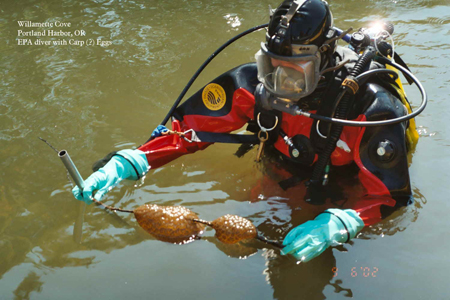Underwater Taking Samples with EPA Divers
by Sean Sheldrake, EPA Region 10 Dive Team and Alan Humphrey, EPA-Environmental Response Team (ERT)
In our last segment, I had just rehearsed with the diver their underwater “dance” of careful movements to safely get the data we need to support our Willamette River cleanup. Now with the diver descending into the murky depths, they are focusing on that rehearsal. The diver will next install the sampling devices and talk to me (the dive supervisor) shipboard the entire time via a communications cable between the boat and the diver—and we will continue to stick with the choreographed maneuvers we have rehearsed. Each movement is calculated. If there is any increase in her/his breathing rate that we can’t control by talking through the causes, the dive will be called off immediately. Once the diver has placed the devices, I’ll ask her/him to back away –downcurrent– carefully from the instrumentation before they come up. “Have you backed off the sampler about 3 feet? Great, ok, let’s start bringing you up nice and slow. We don’t want any of your gear to catch on that sampling equipment.” While we’re doing this, we’re looking for debris, vessel traffic, and anything else that might concern the diver on the surface.
“Diver—um, surface would like to inform you that we have a large armchair inbound.”
“Surface, an armchair?”
“Diver– that’s correct—must have fallen off someone’s dock—we’ll direct you around it.”
Sometimes dancing in polluted water takes various forms.
Once the diver is back on the surface they undergo at least an extensive clean water rinse to ensure that all bottom sediments they may have picked up on their gear is rinsed back into the River, and not brought onto the boat deck to get mixed up in someone’s lunch. Soaps may be used and collected if needed, such as on a diver covered with oil—luckily those were not necessary today.
 Once decontamination is completed, the diver is brought back into the clean zone in the cabin for some water and light food. “One more sample completed, 2 dozen down, 2 dozen to go,” I say. Good science done safely, one sample at a time. The project managers at EPA and ODEQ will later make multimillion dollar cleanup decisions with that data, impacting a host of Willamette River users—a small “sampling” of what EPA divers do.
Once decontamination is completed, the diver is brought back into the clean zone in the cabin for some water and light food. “One more sample completed, 2 dozen down, 2 dozen to go,” I say. Good science done safely, one sample at a time. The project managers at EPA and ODEQ will later make multimillion dollar cleanup decisions with that data, impacting a host of Willamette River users—a small “sampling” of what EPA divers do.
Read more about the latest in EPA scientific diving at www.facebook.com/EPADivers.
EPA video: Sean Sheldrake talks about his job.
About the authors: Sean Sheldrake and Alan Humphrey both serve on the EPA diving safety board, responsible for setting EPA diving policy requirements. In addition, they both work to share contaminated water diving expertise with first responders and others.


Jun 29, 2012 @ 11:37:50
The Progress of Living.-
In fact we must crying and praying to The Ancestors who gave anything for us that agreement should present to our next generation to explore all of they could be……
Jul 04, 2012 @ 07:18:57
Oh, it’s my old little dream – to become a diver.